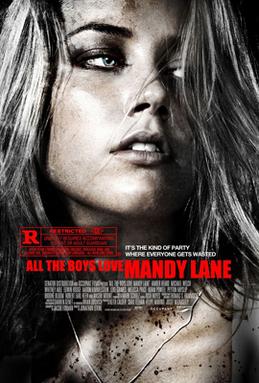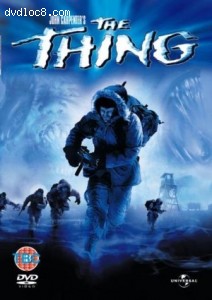 |
| Theatrical release poster |
Title: All The Boys Love Mandy Lane
Director: Jonathan Levine
Year Released: 2006
Budget: $750,000
The opening credits feature a red background
this signifies blood, with the title there is blade slash and a girl screams
hint at what is to come? Also a typical convention for a horror film, the blood
which has appeared on the screen from the blade slash makes it way down the
screen. The shot pans down to a school which appears to be a normal school day.
A song is being played the song could hint at what is to come later on in the film? Mandy Lane then appears in fact of the audience, stereotypical blonde signifier of scream queen. She looks at outsider or new, as she walks through the corridors everyone reacts to her. This is until a friend starts talking to her
During this sequence a range of shots have been used including: establishing shots, close ups, medium shots and long shots.
When outside the school there is a stereotypical teenager who is being cured and offensive, hints at what is to come as this type of person normally dies as well as the scream queen.
The shot scrolls up to establish next scene this is a pool party anchoring the location is America. The event is a stereotypical setting for a pool party, nothing out of the ordinary, normal swimming pool/party clothes. The same music which featured at the start of the film starts again, again hint at what is to come?
Again wide variations of shots are used to focus on people enjoying themselves. The shot takes are short and quickly edited between each other.
The person who was being offensive in the last scenario is still being offensive, her friend water pistols him which turns into a fight, this is used to build up the tension. Another possible hint that something going to happen with these two in the future? Fight shows that is the strong out of the two. Both want the same prize Mandy Lane. Also a use of binary opposites is used: Brain vs. Brawn.
Time of day has changed to night hints that something going to happen? Mandy’s best friend is sitting on the roof, either shows power or he is a loner probably the latter. The guy he previously had a fight with comes to sit with him. Both talks about Mandy (clearly the prize in this film) start to argue about her. The best friend, who so far the audience reacts with sympathy, tricks his rival to jump off the edge to impress Mandy- jealousy? However the guy slips as a result of being drunk - outcome revealed before it happens? Has attracted tension people's attention and are worried although he is still drinking. When he jumps of the shot is similar to that of a point of view however it stops short letting the guy disappear out of shot. The party atmosphere has been replaced by that of screaming - makes the audience tense and want to know what has happened. As the guy enters the pool blood with blood surrounding him - audience is shocked.
IMDB Page: http://www.imdb.com/title/tt0490076/A song is being played the song could hint at what is to come later on in the film? Mandy Lane then appears in fact of the audience, stereotypical blonde signifier of scream queen. She looks at outsider or new, as she walks through the corridors everyone reacts to her. This is until a friend starts talking to her
During this sequence a range of shots have been used including: establishing shots, close ups, medium shots and long shots.
When outside the school there is a stereotypical teenager who is being cured and offensive, hints at what is to come as this type of person normally dies as well as the scream queen.
The shot scrolls up to establish next scene this is a pool party anchoring the location is America. The event is a stereotypical setting for a pool party, nothing out of the ordinary, normal swimming pool/party clothes. The same music which featured at the start of the film starts again, again hint at what is to come?
Again wide variations of shots are used to focus on people enjoying themselves. The shot takes are short and quickly edited between each other.
The person who was being offensive in the last scenario is still being offensive, her friend water pistols him which turns into a fight, this is used to build up the tension. Another possible hint that something going to happen with these two in the future? Fight shows that is the strong out of the two. Both want the same prize Mandy Lane. Also a use of binary opposites is used: Brain vs. Brawn.
Time of day has changed to night hints that something going to happen? Mandy’s best friend is sitting on the roof, either shows power or he is a loner probably the latter. The guy he previously had a fight with comes to sit with him. Both talks about Mandy (clearly the prize in this film) start to argue about her. The best friend, who so far the audience reacts with sympathy, tricks his rival to jump off the edge to impress Mandy- jealousy? However the guy slips as a result of being drunk - outcome revealed before it happens? Has attracted tension people's attention and are worried although he is still drinking. When he jumps of the shot is similar to that of a point of view however it stops short letting the guy disappear out of shot. The party atmosphere has been replaced by that of screaming - makes the audience tense and want to know what has happened. As the guy enters the pool blood with blood surrounding him - audience is shocked.
Wikipedia Page: http://en.wikipedia.org/wiki/Mandy_Lane
















.jpg)




























